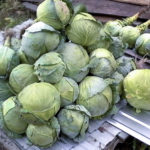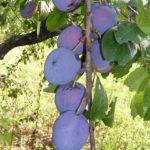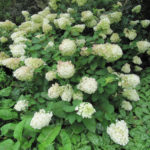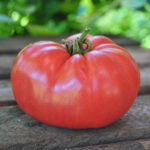Plum variety Alyonushka
Alyonushka is a fairly new, but already popular, early-maturing variety of Chinese plum (Prunus salicina). Bred at the All-Russian Research Institute for Breeding Fruit Crops (Orel) through crossing of 2 varieties - Chinese woman x Red ball. The authorship belongs to A.F. Kolesnikova and G.B. Zhdanova.
In 2001, the variety was added to the state register for the Central Black Earth Region. Grown as an industrial and amateur culture.
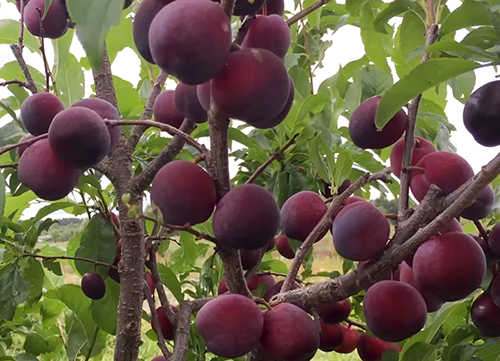
The trees are medium-sized (2 - 2.5 m high), with a raised pyramidal crown of medium density. Shoots are thick, straight, non-pubescent, colored reddish-brown, the integumentary color is expressed in an average degree, the internodes are medium. Lentils are convex, medium in size, rarely located on the shoot. Buds are conical in shape, of medium size, deviation from the shoot is weak. Leaves are light green in color, large in size, oblong-obovate, long-pointed; the apex is sharply pointed, the base is pointed, the edges are with double serrated serration. Leaf blade with a smooth, matte surface, curved upward. Glands from 1 to 3 pieces, they are located on the petiole and base of the leaf. Petioles are of medium thickness, 2 cm long, pigmented.
Inflorescences are three-flowered. Petals are white, touching. The rim is open, 12.7 mm in diameter. The stigma of the pistil is located above the level of the anthers. The calyx is bell-shaped, sepals without serration. The length of the pistil is 8.1 mm, the length of the stamens is 5.5 mm. Fruit formations are tied mainly on fruit twigs.
Plum fruits Alyonushka weighing 30 - 35 g (maximum weight - 50 - 70 g), 3.8 cm high, 4.4 cm in diameter, rounded in shape, with a rounded top and a wide funnel. The main skin color is red, the integumentary color is dark red with an intense waxy bloom. The stalks are of medium thickness, short in length. Bones weighing 1 gram, oval, poor separability from the pulp. The separation from the stalks is good. The fruits are resistant to cracking.
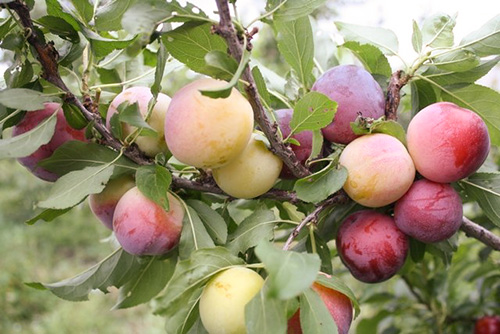
The pulp is orange in color, gristly structure, medium density, juicy, tender, aromatic, with a very good sweet and sour taste. The juice is colorless. The chemical composition of the fruits is as follows: dry matter - 11.6%, the amount of sugars - 8.2 - 8.77%, acids - 1.39 - 1.4%. The attractiveness of the fruit's appearance is assessed on a tasting scale of 4.8 points. Tasting assessment of the taste of fresh plums varies depending on the region of growth from 4.2 to 4.6 points. Table variety, recommended for fresh consumption, but also great for compotes. The average yield is 88.6 c / ha, the maximum reaches 199.8 c / ha.
Flowering takes place in the early stages - in the first ten days of May (approximately 4-8 days). The fruits ripen at an early date: from 15 to 20 August. The early fruiting rate is high: the trees enter the fruiting season in the 3rd year. Fruiting is abundant, regular.
Plum Alyonushka is self-fertile. It is recommended to use the variety as a pollinator. Early... Other varieties of Chinese plum and Russian plum (Alycha hybrid) can also become good pollinators.
The general level of winter hardiness is assessed as average (4 points according to the results of research in the Michurinsky garden of the TSKHA). The frost resistance of flower buds is increased. The variety is relatively resistant to moniliosis and clasterosporium disease (perforated spot).
The variety is of value for breeding work (donor of taste and marketability).
The main advantages of the Alyonushka plum include marketability and high taste properties of the fruit.
The disadvantages include: very high damage to the leaves and young shoots of aphids, podoprevanie bark of the base of the stem during rainy autumn weather and warm snowy winter.Therefore, it is advisable to cultivate this plum on stem-and skeleton-formers and plant it not in a planting pit, but on an elevation.
